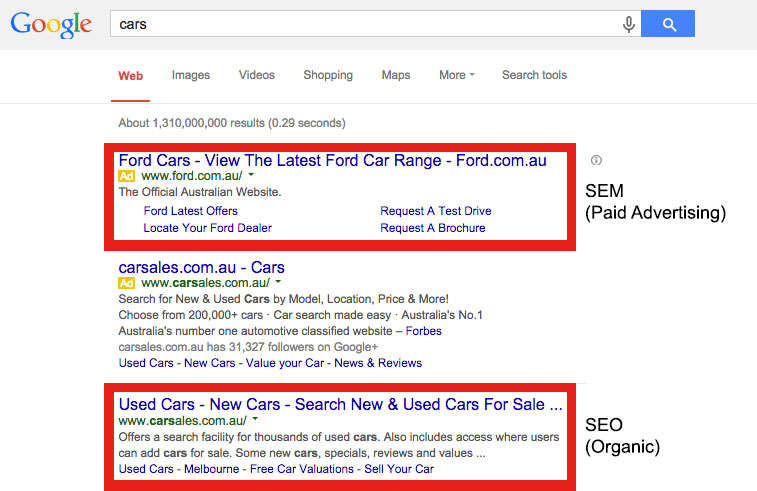It is no revelation that the way we advertise has dramatically changed from 20 years ago. Although a lot of the same concepts still apply (the unique selling proposition come to mind), the mediums that we advertise them on have changed. With new technology comes new mediums, and with new mediums come new techniques for getting the most out of that medium.
The biggest of them all is ‘Search Engine Marketing.’
Search Engine Marketing (also known as “Paid Search Marketing” or “SEM”) is essentially exactly what it sounds like. Utilising the medium of search engines to market to customers.
What is the difference between SEM and SEO?
SEM often gets confused with SEO (Search Engine Optimisation), and although they are related, there is a big difference between the two. SEM is paid advertising and SEO is about optimising organic searches.

If we look at a Google search for ‘cars’, we can see both SEM and SEO at work. The SEM portion of the search is a paid advertisement. If you look closely there is a little yellow square with the word “Ad” next to it in the advertisement. This ad was paid for using a service called Google Adwords.
If you look below, there is also an organic search result. This result came up first (out of the organic results) because the website it is advertising has the most amount of content that is relevant to the term that was searched initially (the term “cars”).
If you notice that above the organic search result for carsales.com.au is a paid SEM result for carsales.com.au too. This is because carsales.com.au is actively running both SEM and SEO concurrently.
Why use SEM?
The primary reason to use SEM is that it targets consumers right at the moment when they are looking to buy. This is because SEM ads only appear when the consumer searches a keyword that is relevant to the ad.
There are many times in “traditional” forms of advertising where the ad reaches the target audience, but it reaches them at the wrong time. For example, let’s say you just bought a new pair of Nike shoes. Now say you see an ad for a pair of Reebok shoes the next day. You realise that you actually like the Reebok shoes better, but you are in a conundrum. You would have gone with the Reebok shoes if you would seen the ad before you had purchased. The issue wasn’t the Reebok ad itself, but the timing of the ad.
If you had seen that Reebok ad earlier, you would have chosen the Reebok shoes over Nike. If you had come in contact with SEM, the moment that you searched “running shoes” on Google, you may have seen the ad for Reebok on the front page and thus, you probably would have bought it instead. Timing is everything.
In addition to great timing, SEM also has the benefit of great coverage.
- 70% of consumers search for local businesses online.
- 76% of people use search engines as an online source for searching product and service information.
- 93% of consumers begin on a search engine.
(Online Marketing Trends Every Business Needs to Know).
The combination of both coverage and timing makes SEM an extremely powerful method of marketing to your target audience when they are ready to buy.
For more information click here



